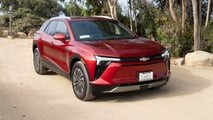As the predicted range dwindled to a mere 11%, a wave of anxiety washed over me. My co-pilot, Meg, and I exchanged concerned glances. It was time to abandon our ambitious plan. Rainbow Viewpoint, Bryce Canyon National Park’s most elevated vista, was our intended destination. However, the reality of 80 miles of frigid, desolate roads stretching between us and the comforting familiarity of our hotel room became a stark concern. Doubt gnawed at me: could Gorbo, our Chevy Blazer EV, truly make it?
Reluctantly, we made a U-turn.
Two hours later, relief washed over us as we pulled into the hotel parking lot, the battery indicator displaying a reassuring 18%. We had overestimated the risk; Gorbo could have indeed reached our initial goal. However, the Blazer’s overly cautious range estimations had instilled a seed of doubt, forcing our retreat. Midway through my extensive 1,200-mile electric vehicle road trip, a complex mix of emotions churned within me. Gratitude for the conservative range predictions warred with annoyance at having missed out on Bryce Canyon’s panoramic splendor. Trust and frustration tangled in equal measure.
This encapsulates my initial six months navigating life with the Blazer EV.
Bryce Canyon holds a special place in my heart, making the missed opportunity to explore its heights all the more poignant. At least we managed to experience the canyon’s majesty through a memorable hike.
The Highlights
Everyday driving in the Blazer EV is a genuine pleasure. My model, a 2024 LT AWD – a launch edition variant comparable to the current 2LT – stands out as a remarkably refined and tranquil vehicle, underpinned by exceptional software integration.
Its spaciousness is another significant advantage. Our 1,200-mile journey from San Diego to Utah saw the Blazer EV transformed into a mobile storage unit, swallowing camping equipment, coolers, tables, chairs, extra clothing, and a myriad of other essentials. We even utilized its cavernous interior for sleeping, the area behind the seats comfortably accommodating two adults (albeit both under 5’7″).
The integrated software suite is a standout feature. The presence of Google Maps negates any sense of longing for Apple CarPlay. Furthermore, the independence from constant phone connectivity is liberating. Short errands no longer necessitate carrying my phone; Spotify and navigation remain seamlessly accessible.
Ground clearance is another unexpected boon. Boasting 7.9 inches of clearance at its lowest point, it surpasses all other mainstream electric SUVs. While the Kia EV9 comes close, the Hyundai Ioniq 5 and Kia EV6 offer a considerably lower, car-like 6.1 inches. Even Jeep’s inaugural electric SUV offering falls short with a modest 6.4 inches. This, coupled with the generous cargo area and expansive rear seating, positions the Blazer EV as the premier electric choice for those who, like myself, prioritize the ability to transport four adults and camping gear down unpaved roads.
If superior off-road capability is desired, the Rivian, electric G-Wagen, or an electric pickup truck become necessary, all of which command a significantly higher price point.
The Blazer EV’s ample ground clearance and short overhangs make it a competent companion on mild off-road trails. However, its extended wheelbase, eco-focused tires, and lack of a spare tire render it less than ideal for truly adventurous excursions.
Acceptable, But Not Exceptional
The EPA-estimated range for my Blazer EV LT AWD is 279 miles. While respectable within its class, it introduces a degree of planning complexity to road trips.
Real-world usage patterns dictate that depleting the battery to zero or consistently charging to 100% are uncommon scenarios. Furthermore, the Blazer’s route planning software exhibits a tendency towards conservatism, ensuring arrivals at charging stations with a battery level exceeding 10%. Consequently, I often found myself arriving with approximately 20% remaining. Given the already moderate charging speeds and their significant drop-off beyond 80% charge, effectively only 60% of the battery capacity was actively utilized, translating to a range of roughly 160-180 miles between charging stops. These stops, moreover, averaged around 35 minutes.
Therefore, the range is best categorized as adequate. It mirrors that of AWD Kia EV6 and Hyundai Ioniq 5 models, and a rear-wheel-drive, extended-range variant is available. However, my road trip underscored the desirability of a 350-mile EPA range for frequent long-distance travel. It’s worth noting that most drivers undertake fewer road trips than they anticipate, and the increased frequency of stops during my journey resulted in arriving in Utah feeling considerably more refreshed than after previous white-knuckle, eight-hour drives in gasoline cars.
This particular charging station, one of the few in the vicinity, resulted in an unavoidable queue. Frustratingly, a sprawling Tesla Supercharger facility with 120 stalls stood adjacent, inaccessible to non-Tesla vehicles at the time.
Driving dynamics fall into the “just fine” category. The Blazer, a substantial and weighty crossover, lacks genuine driver engagement. Its 288-horsepower powertrain, delivering 333 lb-ft of instant torque, provides ample punch for daily driving scenarios. However, aggressive throttle input quickly reveals the limitations of its 5,300-lb mass. Cornering performance is commendable considering its weight, surpassing the Toyota RAV4 or Ford Escape, but driving enthusiasts seeking thrills will find it lacking. Acceptable is the operative word.
Similarly, the sound system and seats are merely satisfactory. Highway cruising in the Blazer is quiet and comfortable, but the unremarkable speakers and seats inspire envy towards Cadillac Lyriq owners. A speaker upgrade is a distinct possibility in my future. While the seats proved adequate for the 1,200-mile journey, a more luxurious and supportive setup would be preferable.
The Disappointments
The MyChevrolet smartphone app is a primary source of frustration. Retrieving the state of charge often takes upwards of a minute, and remote start commands frequently fail. A helpful forum user suggested sending a lock command beforehand to “wake up” the vehicle, which has marginally improved success rates. Intriguingly, a resourceful Redditor discovered that the MyBuick app functions with Chevrolet vehicles and exhibits greater reliability, possibly due to lower user volume. Even with these workarounds, the app experience remains sluggish, cumbersome, and significantly behind the industry benchmark set by Tesla a decade ago.
Attempting to utilize the app to initiate charging at Tesla Superchargers is an exercise in futility. Despite GM’s purported support for Supercharger access via the app, the native Tesla app operates with far greater consistency and user-friendliness. Of course, neither app would be necessary if GM EVs supported seamless, automatic payment and charge initiation at Tesla Superchargers, a feature already implemented by Rivian and Ford. GM, regrettably, lags behind.
Furthermore, while Supercharger access is undeniably valuable, it comes at a social cost: the distinct feeling of being inconsiderate.
Witness this awkward parking situation, straddling stalls and encroaching on gravel. The Rivian owner nearby seemed to share my sentiment.
In most instances, parking across two stalls was unavoidable, and in one case, parking on gravel became necessary. The comically short Supercharger cable necessitated repeated adjustments, inching the Blazer closer to the station, a process far from elegant. It’s an undeniably poor user experience, though not attributable to GM’s design flaws, but rather a consequence of the inherent inflexibility of a charging network predominantly designed for a single manufacturer’s vehicles.
On the return journey, a V4 Supercharger station with 100 stalls and extended-reach cables offered a glimpse of a more user-centric future, a stark contrast to the patchwork, frustrating reality of the present. Charging times also lean towards the longer side. On an optimal day, a 350-kW charger can replenish the battery from 10% to 80% in 40 minutes.
Isn’t this a more harmonious vision? Vehicles charging seamlessly, without the need to occupy multiple stalls. If only restrooms were equally ubiquitous.
Cold weather performance is another area requiring improvement. Our Bryce Canyon experience vividly illustrates the shortcomings of winter range. A 160-mile round trip from Springdale, Utah, to Bryce Canyon, with an additional 20-30 miles within the park itself, seemed well within the Blazer’s capabilities, given its 279-mile EPA range and a starting charge of 100%. However, plummeting temperatures to around 8 degrees Fahrenheit on the second morning, coupled with a significant 4,000-foot elevation gain on the ascent to Bryce, drastically impacted efficiency. For rural road trips in cold climates, extended range is a necessity.
Finally, GM’s quality control leaves something to be desired. A persistent rattle emanating from the headliner remains, despite a prior replacement. The panoramic moonroof often requires multiple attempts – sometimes as many as eleven – to close fully, as its pinch sensor seems to prematurely trigger just before sealing. Another dealer visit will be necessary to address these recurring issues.
To date, three dealer service appointments have been required, a tally I am diligently tracking.
The officially recommended procedure for utilizing the nation’s premier charging network is truly bewildering.
My Verdict So Far
Despite these shortcomings, I remain largely satisfied with the Blazer EV, primarily due to its compelling value proposition. My two-year lease at $8,000 strikes me as a fair price for the overall experience.
The road trip experience is undeniably less refined and necessitates more meticulous planning than a comparable Tesla journey. Adapters are essential, third-party route planners are advisable, and quality concerns may surface.
However, these were anticipated compromises. In return, I’ve gained access to a comfortable, reasonably stylish, and exceptionally practical SUV at a bargain price. There’s a learning curve associated with EV ownership, but that’s precisely the appeal for me. I’m actively exploring how an EV integrates into my lifestyle. The conclusion is that it doesn’t seamlessly replace the ingrained gasoline car paradigm, but it represents a significant step forward.
It also serves as a clear indication that GM still has areas for improvement as it navigates the burgeoning EV market, particularly in software refinement, charging infrastructure integration, and quality control.
But the Blazer EV offers a compelling array of advantages. Lower running costs, enhanced quietness, smoother operation, and a more contemporary technology interface are undeniable benefits. It fosters a sense of optimism, suggesting that current EV ownership hurdles represent the peak of inconvenience, and the overall experience remains remarkably positive. It simply requires a degree of curiosity, adaptability, and a willingness to improvise.
It’s an ongoing adventure, and I’m thoroughly enjoying the ride.
Correction 2/5/25 at 1:50 PM ET: An earlier version of this article mistakenly said that the Blazer’s navigation system says it cannot charge at Superchargers. That is incorrect, it says that by default but you can update the system via the charging filters option, after which the car will find and route to Superchargers properly. We regret the error.
Contact the author: [email protected].
More Long-Term Reviews From The InsideEVs Fleet
I’m A Gas Car Fan. Here’s Why I Love My First EV
Chevy Blazer EV Long-Term Test: Two Dealer Visits In Two Months
Chevy Blazer EV: Why I Traded My 20-Year-Old Gas Truck For This
2024 Kia EV6 Long-Term Test: Let’s Talk Winter Range And Performance
2024 Kia EV6 Long-Term Test: Lessons From An Electric Road Trip
2024 BMW iX xDrive50 Long-Term Review: Extreme Cold, Software Woes
Share this Story
Got a tip for us? Email: [email protected]


